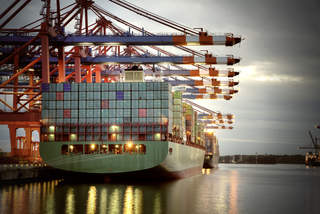
© fotolia/robertmandel
The Preference Utilisation Rate of EU Free Trade Agreements
For the past four years, the European Commission has published reports on the practical application and implementation of European free trade agreements (FTAs) over the past two years. The reports contain data on preference utilisation rates (PUR) organized by Member States, industry sectors, and trading partners. The PUR indicates the value of trade that takes place under preferences as a share of the total value of trade that is preference eligible in an FTA. According to these reports, the average EU preference utilisation rate was 67 percent (2021).
Germany, which was responsible for 29 percent of extra-EU exports (Eurostat), had a preference utilisation rate of 60 percent for its exports, below the average of 67, in 2021. It is, however, tied for 20th place in the Union with Hungary and Latvia. The Spanish export preference utilisation rate, for example, is significantly higher in second place with 77 percent, although it was only responsible for 5.6 percent of extra-EU exports in 2021. German exporters therefore demonstrate clear potential to increase their competitive advantage by better utilizing the preferential tariffs agreed in the trade accords of the European Union.
Utilisation of European FTAs by German Exporters
Through an updated comprehensive survey of German companies and expert interviews at German and European level, BDI has sought to examine the key challenges that German exporters face in their utilisation of EU FTAs. The results of this study build on the perspectives of 18 branches of industry.
According to the BDI study, the five factors that most hinder the utilisation of EU FTAs by German exporters are:
- the extensive costs and bureaucracy associated with compliance with the rules of origin;
- narrow tariff margins (the difference between the general MFN tariff rate under WTO rules and the preferential tariff rate of the specific FTA);
- inadequate internal capacity to manage the usage of FTAs;
- variance of rules across several EU FTAs, and
- high compliance risks associated with goods clearance on the basis of complex supply chains.
More than half (53 percent) of surveyed companies indicated that there are FTAs that they do not utilise, although they maintain trading relations with the country/countries with which the agreements were concluded. Furthermore, a significant 87 percent of surveyed companies and associations estimated that companies in their branch of industry do not take full advantage of the free trade agreements of the EU.
Improving the Preference Utilisation Rate
There are many ways to make the utilisation of EU FTAs for merchandise trade more attractive and to better take advantage of the untapped potential in the agreements. The rules of origin should be significantly simplified and harmonized across agreements. This would reduce administrative expenses and better facilitate the implementation of the rules within IT systems. German industry advocates for consistent, cross-industry value-added rules. In addition, BDI calls for greater coherence of product-specific rules of origin. A uniform European IT user interface would also significantly simplify the process of collecting supplier declarations.
Many free trade agreements apply the direct transport principle. In order for a good to qualify for preferential tariff treatment, it must be shipped directly from one partner country of the agreement to the other. As a consequence, companies that use central storage facilities (hubs) for long delivery routes often do not benefit from preferential tariffs. The problems associated with the direct transport principle and the use of regional hubs could be solved by innovative technologies such as process standardisation based on blockchain.
Finally, chains of communication with customs authorities in partner countries should be improved in order to quickly and efficiently identify and solve possible problems and challenges in goods clearance. The private sector should already be involved during the negotiation process in order to more quickly and precisely identify potential problems in FTA utilisation.



